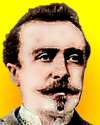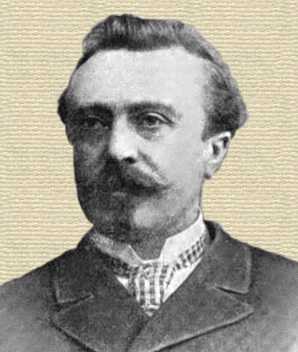 (source)
(source)
|
Charles Joseph Van Depoele
(27 Apr 1846 - 18 Mar 1892)
Belgian-American inventor who was a pioneer in railway, electric lighting, and mining work, with more than 100 patents on electrical inventions. He designed electric streetcar systems for several cities.
|
Charles J. Van Depoele
from The Mechanical News (1 Oct 1892)

[p.338] IT is but natural that one who has done so much for electric railroads should have been brought up among railway men and railway shops. Charles J. Van Depoele, whose portrait forms the frontispiece of the present issue and for which, together with the following particulars, we are indebted to the courtesy of the Electrical Engineer, was born at Lichtervelde, Belgium, in 1846, and from an early age displayed an interest in machinery, the taste being inherited from his father, who was for several years master mechanic of the East Flanders Railway shops at Poperinghe. In 1856 young Van Depoele saw the telegraph system of the road put up, and by the time it was completed was perfectly familiar with the apparatus and its modus operandi. He built apparatus of his own of the same nature, and read through every book the college offered on natural philosophy and electricity. When he had reached the age of thirteen his father was so well satisfied that he brought his education to a summary end in spite of the appeals of his professor and the principal of the college. Nothing else would do but an apprenticeship in cabinet making; and the boy was set to work planing rough boards, on the magnificent allowance of five cents per week.
In the odd hours of his scanty leisure he still built and experimented with electrical apparatus. He made a Ruhmkorff coil with No. 34 wire, using an automatic winder of his own design; but his father found it out, and, believing his prospects to be imperiled, confiscated his books and destroyed the coil. He was then put in charge of an uncle and aunt, who were strictly enjoined to “keep him out of mischief”; and as his working hours often ran from 3:30 a.m. until 9 p.m., it may be surmised that he had little chance to indulge in his favorite pursuit. Still he did contrive to make sulphurous acid before daybreak, and, of course, was found out, the process not being one that lends itself to easy concealment.
At the age of sixteen he had mastered his trade. He was set up in a shop of his own, and soon employed half a dozen men, making all kinds of furniture. He seized every opportunity for study, and went so far as to construct a Bunsen battery of 40 cells. This, however, was carefully hidden from his father, between the joists of the top floor of the house, and there was left when the family removed to Lille, France, in 1864. Young Van Depoele did not take kindly to the furniture industry which his father established there successfully, and therefore was allowed to secure a position in the sculpturing ateliers of Buisine-Rigot, where some 250 artists and artisans were employed. He soon rose to the position of foreman, and also distinguished himself by making an altar for a church at Shanghai, China, an immense piece of carved work sixty feet high by forty feet wide. He now made plenty of money, part of which went to his mother, but no small portion was spent on electrical books and apparatus. The paternal restraint and disapproval were, however, very irksome, and at last he resolved to come to America, where he would be free to gratify his tastes to the full.
He arrived in Detroit in the summer of 1869, and there, with a Belgian friend, started the manufacture of art furniture, thus being a pioneer [p.339] in that now great and prosperous industry of the West. As the business grew, the income grew, and Van Depoele built himself a battery of one hundred Bunsen cells, with which he produced the electric light. From that time on, for several years, despite the wishes and protests of his friends, he spent all of his leisure and much of his ample revenues from the furniture business in electrical experiments. When the Gramme machine was brought out he at once made a dynamo after the description given, and was so much gratified with the results that he constructed several other machines of the same type. So interested was he that, though the day was devoted religiously to his business, he was delighted when the hour came for the men to quit work, and he was at liberty again to try some new experiment.
Mr. Van Depoele not only gave attention to the development of his arc lighting system, but investigated the question of electric power, and worked out various devices for “telpherage” and the running of tools by electric motor. A great hobby of his was the propulsion of street cars by electricity, in which his first experiments were made in 1882. His first commercial road was equipped in 1885 at South Bend, Ind., where five cars were run at one time—something never done before, and even then regarded very sceptically. The work thus begun went on apace, and by 1888 the Van Depoele Company had no fewer than thirteen roads in operation on the overhead-wire system, the plans and designs for all the apparatus throughout being worked out by himself, and many of the roads remaining in successful operation to this day on the original methods.
In the spring of 1888 the Van Depoele Company sold out their electric railway system, patents and business to the Thomson- Houston Electric Company, of Boston, whose service Mr. Van Depoele thereupon entered as electrician of the railway department. Everyone is familiar with the enormous strides made by that company in electric railway work since that time.
It is worthy of mention that Mr. Van Depoele claims to have been the first to run a number of cars from a single source of constant potential, using separately excited generators. In the fall of 1885, when the South Bend road was constructed, he had five cars in operation, four of 7 h.p. and one of 10 h.p., the motors being under the car floor. At the time he did this, no road, it is said, had more than two cars at most in operation at the same time.
Not only has Mr. Van Depoele developed the lighting and traction systems bearing his name, but he has produced a great number of commutatorless motors, both rotary and reciprocating, the latter being specially adapted for rock drilling. In fact, some of his drills were tested for coal mining as far back as 1885. He has lately devoted considerable attention to the subject, and promises to bring out soon some perfected apparatus. These drills are operated by direct pulsating currents, require no commutation, and owing to their extreme simplicity are not liable to get out of order. Mr. Van Depoele is applying the same principle to forge hammers, riveting, etc.
This brief record does bare justice to the persistency with which Mr. Van Depoele carries out his inventions and ideas. He is indefatigable, and is also able to maintain his good nature and courage amid disheartening difficulties and setbacks. In capacity for hard work he is not excelled.
- 27 Apr - short biography, births, deaths and events on date of Van Depoele's birth.
- Charles Joseph Van Depoele - Obituary - from Transactions of the American Institute of Electrical Engineers (1892).
- Charles Joseph Van Depoele - patent numbers and titles of his 243 U.S. Patents from 1881-1894.




